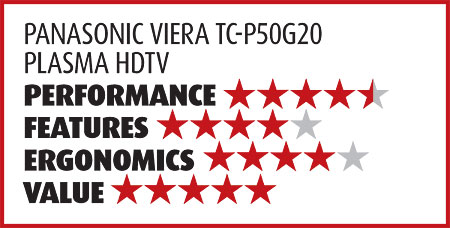Panasonic Viera TC-P50G20 Plasma HDTV Page 3
The best Blu-ray Discs looked even better. As I write this, I’m only halfway through the extended International Edition of the Chinese epic Red Cliff. While the battle scenes are intense, they’re more than a little unrealistic. (Lone warrior defeats dozens of the enemy, while hundreds of other enemy soldiers stand around watching. Check. Happens every day.) The characters are also a little confusing at first.
It took me a good third of the movie to tell who from Woo. But the cinematography is luscious. On the 50-inch Panasonic, it was eye-popping. The brilliantly colored and detailed Pirates of the Caribbean: The Curse of the Black Pearl also jumped off the screen, and Armageddon has never looked better than it does in its new Blu-ray transfer on the Panasonic.
I hardly need to note—but I will—that like plasmas in general, the TC-P50G20 can run circles around any LCD when it comes to the lack of motion blur. Many current LCDs offer frame-interpolation features that smooth motion blur but totally compromise the intended look of filmbased material. Plasmas don’t need this band-aid to provide smooth motion. You can also fully enjoy the Panasonic’s picture from as far off axis as anyone would care to sit—something no LCD we’ve seen can manage.
The Panasonic’s picture always had plenty of snap. There was never any sign of the infamous gray fog that cripples the dark scenes on some HDTVs, particularly low-end LCDs. Most dark scenes, which typically have enough bright highlights to keep them from sliding into murkiness, looked good. Shadow detail was impressive. On the Blu-ray Disc of Sunshine, I saw more of the structural details on the dark side of the space ship Icarus than I do on most displays.
It was only on the darkest images, such as some of the night shots in The Pacific, fadeouts to a completely dark screen, or the black bars on a 2.35:1 widescreen movie, that the Panasonic’s blacks are more grayish than the Infinite Black claim suggests.
The latter was the source of some disappointment. This letdown had little to do with the quality of this Panasonic’s blacks per se. On average, they were about the same as the last few Panasonic sets we’ve reviewed and thus very good. For the most part, the currently available sets that can do better—or at least those we have tested—are far more expensive.
Rather, my disappointment came from excessive expectations. Rumors arose in the past year (now unofficially confirmed) that many of Pioneer’s KURO engineers had moved over to Panasonic when Pioneer got out of the video business. Based on that, we—and other video enthusiasts—were hopeful that Panasonic’s Infinite Black technology meant that KURO was back, with only the name changed. But for this year at least, that is definitely not the case—at least not in the G20 line.
It was probably wishful thinking on my part to expect a $1,500 set to offer the sort of performance that once commanded a $5,000 price. Set makers this year, including Panasonic, are putting most of their engineering resources into 3D. But for the future, we can hope that Panasonic will give us the true black-level break-through we know it’s capable of.
Conclusions
Despite our unrealistic hopes for this latest Panasonic’s black level, the TC-P50G20 plasma remains an exceptional value. With its good blacks and excellent shadow detail, plus exceptional color and resolution, I can’t imagine anyone regretting the decision to make this their next HDTV. On the contrary, caveat emptor. Which in English means, bring one home only if you’re prepared to watch entirely too much television.














































